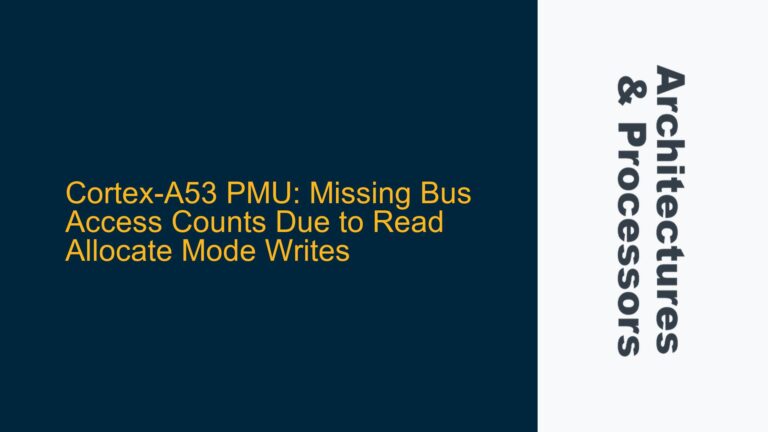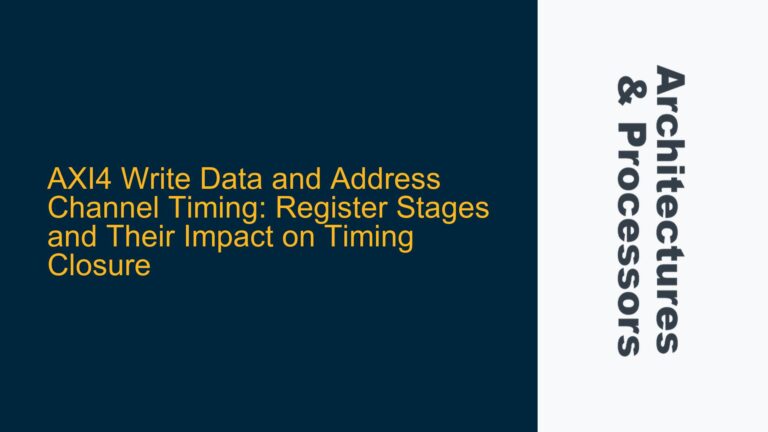AXI4 Interconnect Behavior with Single Master and Multiple Slaves
In an AXI4-based system with a single master and multiple slaves, the behavior of the interconnect plays a critical role in ensuring proper transaction ordering and response management. The AXI4 protocol mandates that responses to transactions initiated by a single master must be returned in the order they were issued. This requirement holds even when the transactions are directed to different slaves, which may have varying response latencies. The interconnect must ensure that the master receives responses in the correct order, regardless of the order in which the slaves complete their transactions.
The core issue arises when the master issues multiple read transactions with the same transaction ID (ID = 0) to different slaves (Slave A and Slave B). The interconnect must route these transactions to the respective slaves and manage the responses to ensure they are returned to the master in the order they were issued. This becomes particularly challenging when Slave B completes its transaction before Slave A, as the interconnect must ensure that Slave A’s response is delivered to the master first.
The AXI4 protocol does not require the interconnect to modify transaction IDs when routing requests to different slaves in a single-master system. However, the interconnect must implement mechanisms to enforce response ordering. This can be achieved through buffering, stalling, or other flow control techniques. The interconnect must also ensure that it can correctly associate responses with their corresponding transactions, even when responses arrive out of order from the slaves.
Transaction ID Handling and Response Ordering Requirements
The AXI4 protocol specifies that transaction IDs are used to differentiate between multiple outstanding transactions. In a single-master system, the master typically uses the same ID for all transactions unless it needs to issue concurrent transactions to the same slave. When the master issues transactions to different slaves, the interconnect does not need to modify the transaction IDs, as there is no ambiguity in identifying the source of the transactions.
However, the interconnect must ensure that responses are returned to the master in the order the transactions were issued. This requirement is critical for maintaining the correctness of the system, especially in scenarios where the master relies on the order of responses to proceed with subsequent operations. For example, if the master issues a read transaction to Slave A followed by a read transaction to Slave B, it expects to receive the data from Slave A first, even if Slave B completes its transaction earlier.
To achieve this, the interconnect must implement mechanisms to enforce response ordering. One approach is to buffer responses from slaves that complete out of order and release them to the master only when the preceding transactions have been completed. Another approach is to stall the faster slave by holding its RREADY signal low until the slower slave has completed its transaction. Both approaches require the interconnect to maintain state information about the order of transactions and the status of each transaction.
The interconnect must also ensure that it does not introduce unnecessary latency or complexity in handling transactions. Modifying transaction IDs or adding additional bits to the ID field is not required in a single-master system, as the interconnect can rely on the order of transactions and the uniqueness of the transaction IDs within the context of the master.
Implementing Response Ordering Mechanisms in the Interconnect
To address the challenge of ensuring response ordering in a single-master multi-slave AXI4 system, the interconnect must implement specific mechanisms to manage transactions and responses. These mechanisms include buffering, stalling, and state tracking.
Buffering is a common technique used by interconnects to handle out-of-order responses. When the interconnect receives a response from a slave, it checks whether the response corresponds to the next expected transaction in the sequence. If the response is out of order, the interconnect buffers the response until the preceding transactions have been completed. Once the preceding transactions are complete, the interconnect releases the buffered response to the master. This approach ensures that the master receives responses in the correct order, regardless of the order in which the slaves complete their transactions.
Stalling is another technique that can be used to enforce response ordering. When the interconnect detects that a faster slave is about to complete its transaction before a slower slave, it can stall the faster slave by holding its RREADY signal low. This prevents the faster slave from sending its response to the interconnect until the slower slave has completed its transaction. Once the slower slave’s response has been sent to the master, the interconnect can release the stall and allow the faster slave to send its response. This approach avoids the need for buffering but requires careful management of the RREADY signal to avoid deadlocks or excessive latency.
State tracking is essential for both buffering and stalling mechanisms. The interconnect must maintain a record of the order in which transactions were issued by the master and the status of each transaction (e.g., pending, completed). This information allows the interconnect to determine when it is safe to release a buffered response or release a stall on a slave. The state tracking mechanism must be designed to handle the maximum number of outstanding transactions supported by the system and must be robust enough to handle edge cases, such as transaction timeouts or errors.
In addition to these mechanisms, the interconnect must also ensure that it does not introduce unnecessary complexity or latency. For example, modifying transaction IDs or adding additional bits to the ID field is not required in a single-master system, as the interconnect can rely on the order of transactions and the uniqueness of the transaction IDs within the context of the master. Instead, the focus should be on implementing efficient and reliable mechanisms for enforcing response ordering.
By implementing these mechanisms, the interconnect can ensure that responses are returned to the master in the correct order, even in a system with multiple slaves and varying response latencies. This ensures the correctness and reliability of the system while minimizing the impact on performance and complexity.






